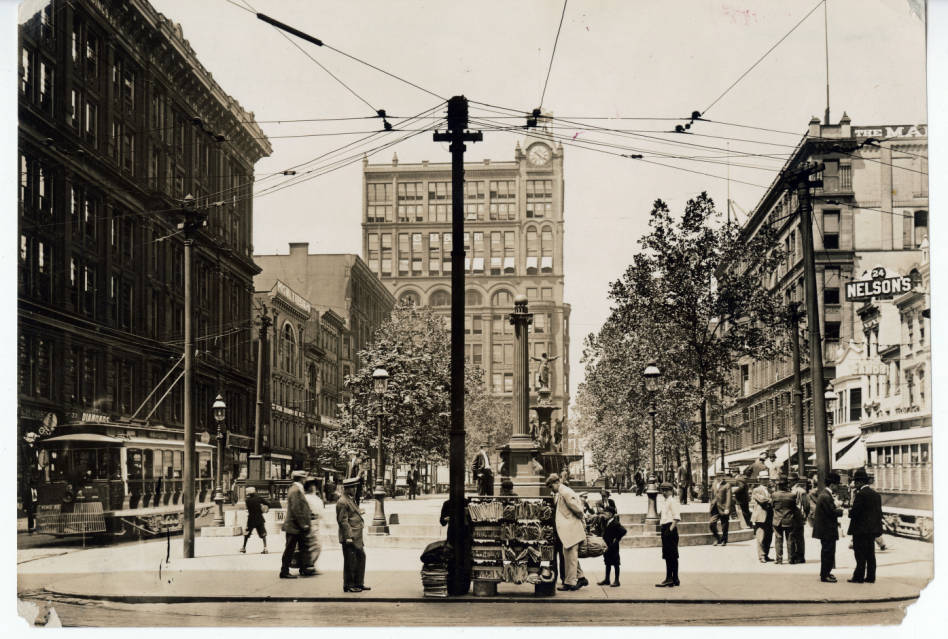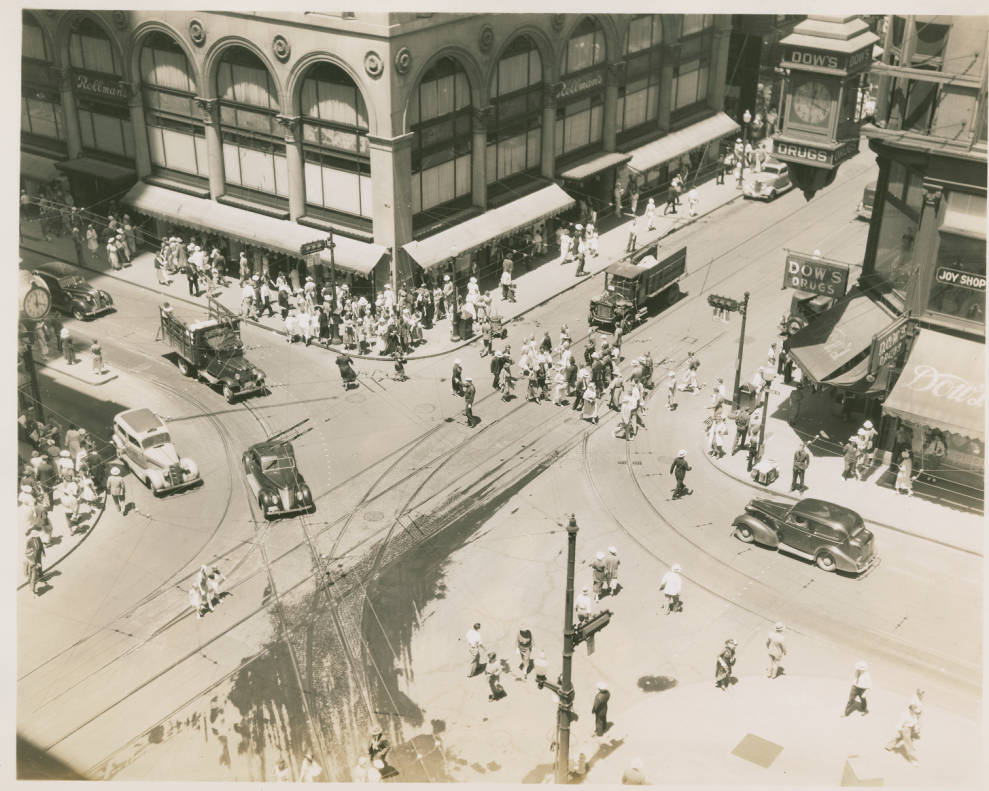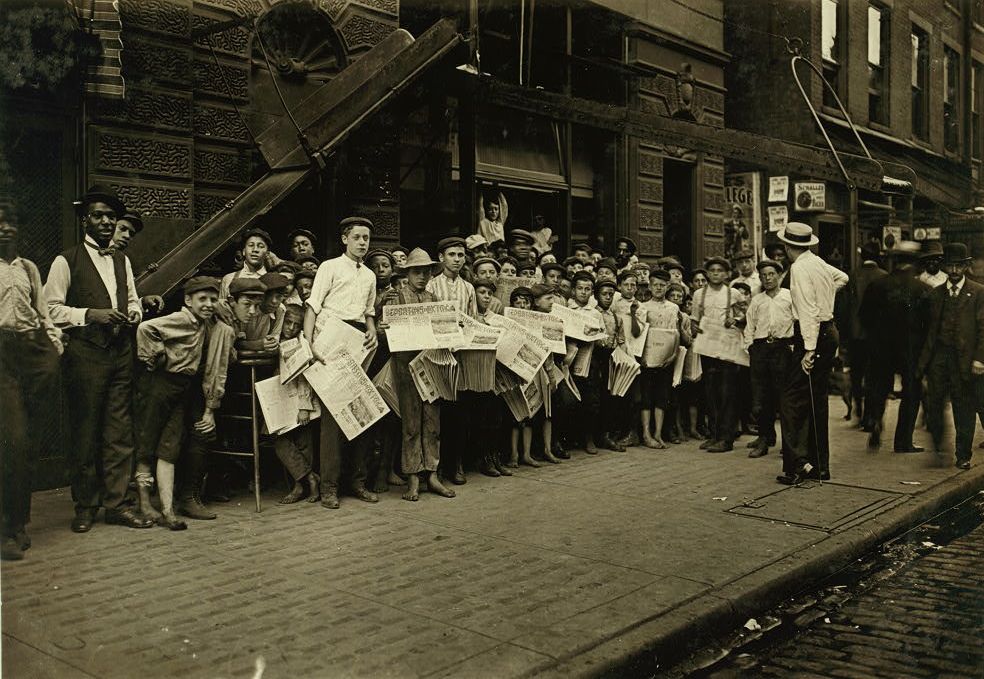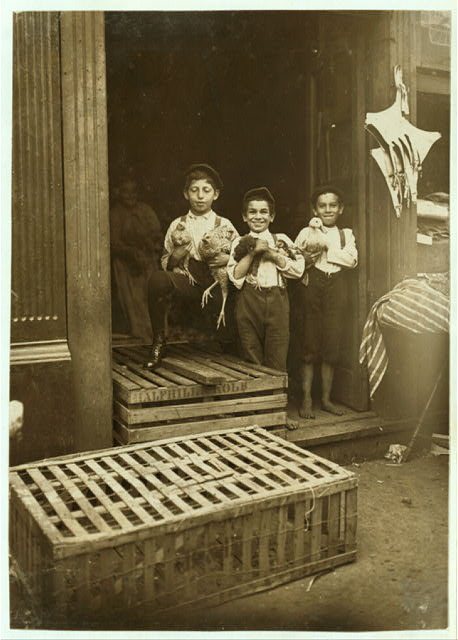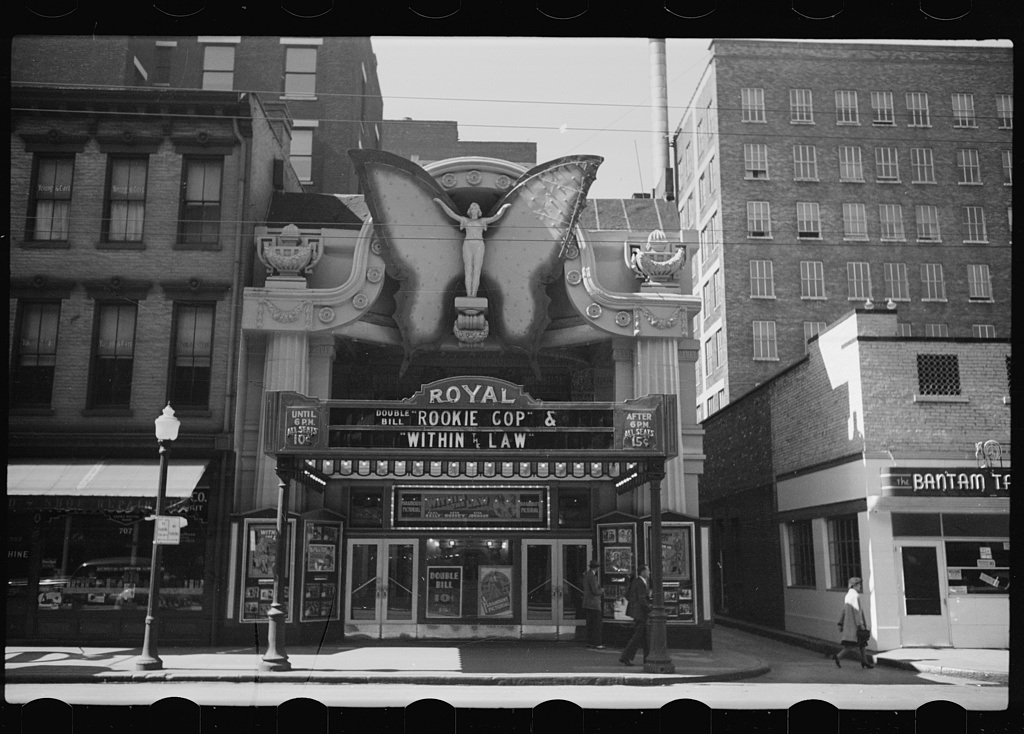Activities
Written by cinci on . Posted in Unit 2: History.
Student Readings
Written by cinci on . Posted in Unit 2: History.
Student Reading 2.6: The Last Standing of the Nine Public Markets
Written by cinci on . Posted in Student Readings.
During the 18th and 19th centuries, stores as we know them today did not exist. Instead there were public markets that residents could travel to and purchase many items including perishable foods. Perishable foods are foods that can go bad quickly. Some of those items could have been eggs, milk, cheese and meats. These public markets served the needs of the city.
Cincinnati had nine public markets. Out of all of these only one remains today. Findlay Market has truly changed and grown with our city. But what happened to the other eight markets?
Over time as peoples’ needs grew so did the demand for services. Not all markets could keep up with the change of the ever growing Cincinnati area. Some markets simply closed. The markets in downtown Cincinnati began to decline with construction of the five inclines that provided transportation from the crowded city to other neighborhoods further away. When people began moving away from the city, the need for the city markets changed. Many markets relocated further away, and people did not have to come to the city to shop, but could shop by their homes. More markets closed with the inventions of home refrigerators and automobiles. People now were able to store their own food and travel around on their own. They did not need one place to shop.
Today you will take a closer look at four of the nine public markets. At the end you should be able to make inferences to why those four markets do not exist today.
Pearl Street Market was the oldest public market in Cincinnati. It started in 1816. This market stood between Broadway and Sycamore Street in the downtown area. It had a large tower with a bell hanging from it. The market sold and provided food and items for the people in town. In 1934 it was torn down and today the Great American Ballpark sits where it once stood. The bell from Pearl Street Market’s tower hangs at Findlay Market.
Fifth Street Market was built in 1829 on land deeded to Cincinnati to be used only for a market. A deed is a legal document that shows who owns the land and/or property. After the Civil War a large political and legal battle began over the deed. Some people wanted the market torn down to build a fountain. In 1870, city council agreed and sent people to demolish the market. The market was demolished to prepare for construction of the Tyler Davidson Fountain. Today many of you have been to Fountain Square and have seen this fountain. It is considered the heart of our downtown area.
Court Street Market was built in 1864 on Court Street between Vine and Walnut to replace the Canal Street Market. This market was closed in 1912 by the City Board of Health for unsanitary conditions. Unsanitary means the market was dirty and full of germs. It was torn down in 1914.
Jabez Elliott Flower Market opened in 1894 in the downtown Cincinnati area. This market was very large and sold only flowers. Mary Holroyd donated $10,000.00 to this market. Mary gave this gift in memory of her first husband, Jabez Elliott. In the 1950 with Cincinnati’s ever growing city, the market was demolished to make room for a parking lot.
Findlay Market has thrived because it was located in a highly populated area and the residents chose to shop there. Built over 160 years ago, the market is still thriving today.
Unit 2: History
Written by cinci on . Posted in Unit 2: History.
Common Core State Standards and Social Studies Grade 3 Content Statements Addressed:
- Activity 2.1: CS1 and CS2; CCSS-ELA: RI.3.3, RI.3.4, SL.3.1, SL.3.4, W.3.8
- Activity 2.2: CS1 and CS2; CCSS-ELA: RI.3.3, RI.3.4, SL.3.1
- Activity 2.3: CS5; CCSS-ELA: SL.3.1a, SL.3.1b, SL.3.1c, SL.3.1d
- Activity 2.4: CS8; CCSS-ELA: RI.3.1, RI.3.2, W.3.4, RI.3.3, RI.3.9
- Activity 2.5: CS2 and CS3; CCSS-ELA: RI.3.3, RI.3.7, W.3.6, W.3.8
- Activity 2.6: CS2 and CS3; CCSS-ELA: RI.3.3, RI.3.7, W.3.6, W.3.8
- Video: Harriet Beecher Stowe: CS8 and CS10
Essential Question:
- How have local communities within Cincinnati changed over time as a result of agriculture, industry and natural resources?
I Can Statements:
- I can explain how Cincinnati’s diverse culture groups have influenced local communities.
- I can create a timeline to show events in Cincinnati’s history.
- I can identify how businesses and industries have changed local Cincinnati neighborhoods.

Additional Resources
Written by cinci on . Posted in Unit 2: History.
Ohioana Library History Resources
- Cincinnati Revealed by Kevin Grace & Tom White (Arcadia Publishing, 2002).
- Historic Downtown Cincinnati by Kent Jones & Steven J. Rolfes (Arcadia Publishing, 2011).
- Mid-Century City: Cincinnati at the Apex, the Photographs of Sarge Marsh by John Fleischman and Sarge Marsh (Orange Frazer Press, 2006).
- Cincinnati (Black America Series) by Gina Ruffin Moore (Arcadia Publishing, 2007).
- Frontiers of Freedom: Cincinnati’s Black Community, 1802-1868 by Nikki Marie Taylor (Ohio Univ. Press, 2005).
- German Cincinnati by Don Heinrich Tolzmann (Arcadia Publishing, 2006).
- German Heritage Guide to the Greater Cincinnati Area by Don Heinrich Tolzmann (Little Miami Publishing Co., 2003).
- Cincinnati Moments: A Celebration of Photographs from the Cincinnati Enquirer by Cliff Radel et al. (Cincinnati Enquirer, 2000).
- Cincinnati’s Hyde Park: A Queen City Gem by Gregory Rogers (The History Press, 2010).
- Cincinnati’s Over-the-Rhine by Kevin Grace (Arcadia Publishing, 2003).
- Lost Cincinnati by Jeff Suess (Arcadia Publishing, 2015).
History Resources
- Free Timeline Maker – www.myhistro.com
- German Heritage Museum and German-American Citizens League – www.gacl.org
- The Cincinnati Observatory – http://www.cincinnatiobservatory.org/
- William Howard Taft National Historic Site- http://www.nps.gov/wiho
- William Howard Taft Childhood Home- http://www.nps.gov/nr/twhp/wwwlps/lessons/15taft/15taft.htm
- Benjamin Harrison’s Birthplace- http://www.northbendohio.org/BenjaminHarrison.html
- William Henry Harrison’s Tomb- http://www.ohiohistorycentral.org/w/Harrison_Tomb
- Houghton Mifflin Social Studies Communities: Read and Interpret a Timeline p.116-117, Create timelines of important events, business in Cincinnati. Example history of Graeter’s, Larosa’s, The Underground Railroad, Public Schools
- The Harriet Beecher Stowe House- http://www.stowehousecincy.org/
- Montessori For Everyone Material- Christ as the center of our Universe A.D. and B.D. timelines http://www.montessoriforeveryone.com/assets/PDF/Christ_Center_of_History.pdf
- Cincinnati Founded Businesses:
- Ohio Community Studies Weekly
- Ohio Community Studies Weekly, Week 4, Sources of Information
- Ohio Community Studies Weekly, Week 5: Communities Change
- Ohio Community Studies Weekly, Week 8: Changing the Environment
- Digging Cincinnati History- This website provides information, maps and primary sources about Walnut Hills. http://www.diggingcincinnati.com/
- City-Data.com- This website provides an overview about the growth and prosperity of Cincinnati. http://www.city-data.com/us-cities/The-Midwest/Cincinnati-History.html
- National Underground Railroad Freedom Center- This site provides lesson plans on the Underground Railroad, the Civil War and contemporary slavery. http://freedomcenter.org/educators/lesson-plans
- A Little History + Some Facts- This website provides information about the history of Cincinnati. http://www.cincinnativiews.net/facts.htm
- Doing History: Investigating With Children in Elementary and Middle Schools by Linda S. Levstik & Keith C. Barton. This book includes information on the sociocultural context of teaching history and building communities of historical inquiry.
- Ohio Made Products (2013)- http://development.ohio.gov/files/research/B2006.pdf
- Tolzmann, D. (2005). German Cincinnati. Charleston, SC: Arcadia.
- The Public Library of Cincinnati and Hamilton County Recommended Reading List- http://www.cincinnatilibrary.org/booklists/?id=cincinnatifiction
- Cincy.com- This website provides information about the history of downtown, the railroad, fountain square, the canal system, the Taft museum, as well as historic photographs. http://www.cincy.com/home/neighborhoods/parms/1/hood/downtown/page/history.html
- Tolzmann, D. (2011). German Cincinnati revisited. Charleston, S.C.: Arcadia Pub.
- Grace, K. (2012). Irish Cincinnati. Charleston, S.C.: Arcadia Pub.
- Ciafardini, P., & Casebolt, P. (2008). Italians of Greater Cincinnati. Charleston, SC: Arcadia Pub.
- Cincinnati’s Findlay Market. ISBN-13: 9780981927121 Publisher: Edgecliff Press.
General Resources
- National Register of Historic Districts in Cincinnati- The City of Cincinnati has 28 separate districts listed in the National Register. http://www.cincinnati-oh.gov/planning/historic-conservation/national-register-historic-districts/
- Museums & Historic Sites of Greater Cincinnati- http://historicgreatercincinnati.org/
- Cincinnati USA.com- Cincinnati USA.com is the official travel guide of Cincinnati and Northern Kentucky. It contains an array or pictures from the Greater Cincinnati area, ideas for trips around the area, as well as an up to date calendar of events. http://cincinnatiusa.com/
- Cincinnati Museum Center- This website provides information about the city of Union Terminal prior being re-purposed as a museum. It also has information about the current exhibits, ticket pricing and resources. https://www.cincymuseum.org/union-terminal
- Cincinnati History Library and Archives- The Cincinnati History Library and Archives has been collecting and preserving materials relating to the Greater Cincinnati area since 1831 and contains photographs, manuscripts, and many more digital resources. http://library.cincymuseum.org/
- Pinterest- This website has a number of lesson plans, activities and resources related to 3rd grade social studies. https://www.pinterest.com/tracyhunt1/third-grade-social-studies/
- Ohio Memory- This digital library is the result of a collaboration project between The Ohio History Connection and The State Library of Ohio. It contains collections from more than 360 cultural heritage institutions from all of Ohio’s 88 counties. http://www.ohiomemory.org/
- Ohio History Central- Ohio History Central is an online encyclopedia that includes information about Ohio’s natural history, prehistory, and history. It is researched and written by staff at The Ohio History Connection. http://www.ohiohistorycentral.org/w/Welcome_To_Ohio_History_Central
- Library of Congress- The Library of Congress is the nation’s oldest federal cultural institution and serves as the research arm of Congress. It is also the largest library in the world with millions of books, recordings, photographs, maps and manuscripts. https://www.loc.gov/
- Novels
- Miller, Zane L. Visions of Place: The City, Neighborhoods, Suburbs, and Cincinnati’s Clifton, 1850-2000. Columbus: Ohio State UP, 2001. Print.
- Cayton, Andrew R. L. Ohio: The History of a People. Columbus: Ohio State UP, 2002. Print.
- Hurt, R. Douglas. The Ohio Frontier: Crucible of the Old Northwest, 1720-1830. Bloomington: Indiana UP, 1996. Print.
The Royal Theatre of Cincinnati
Written by cinci on . Posted in Primary Sources.
This photo was taken by John Vachon in September 1939 and depicts the Royal Theatre on Vine Street. Today, Cincinnati remains the cultural center of Southwestern Ohio, Northern Kentucky, and southern Indiana. Numerous theaters operate in the city, including the Aronoff Center for the Arts — home of the Cincinnati Ballet and the Cincinnati Opera, the Emery Theater, the Taft Theater, the Showboat Majestic, the Playhouse in the Park, the University of Cincinnati College Conservatory of Music, and Music Hall. More than one hundred art galleries exist in the city and the surrounding area. The most prominent ones are the Cincinnati Art Museum, the Contemporary Arts Center, and the Taft Museum.
Courtesy of the Library of Congress, LC-USF33-001631-M2
This photo depicts the Royal Theatre on Vine Street. The Royal Theatre opened in 1910. It closed on July 31st, 1979 making it the longest continuously operating theatre in downtown Cincinnati.
Questions:
- What is unusual about the architecture of this building?
- Why do you think this building, (and others like it) are no longer found in downtown Cincinnati?
Sixth Street Market
Written by cinci on . Posted in Primary Sources.
Three young boys named Heyman Mormer, age 9, Willie Mormer, age 12 and Reubenstein, age 12, sell chickens at the Sixth Street Market in Cincinnati Ohio in August of 1908. This photograph was taken by Lewis Wickes Hine. Within this building were the offices for the City Superintendent of Markets, Weights and Measures. The Sixth Street Market was torn down in 1960 to build what is now the 1-75 freeway.
Courtesy of the Library of Congress, LC-DIG-nclc-03190
Three young boys sell chickens at the Sixth Street Market in Cincinnati Ohio in August of 1908. The Sixth Street Market was built in 1895 and consisted of a large, unheated masonry structure with 64 indoor stalls.
Questions:
- Where do you think the boys are? How do you know?
- What do you think was the job of the City Superintendent of Markets, Weights and Measures? (requires research)
- What do you think the chickens will be used for? How might this process be different today?
The Cincinnati Newsies
Written by cinci on . Posted in Primary Sources.
This image was taken in August 1908 by Lewis Wickes Hine. The Cincinnati Times-Star, located at 800 Broadway Street, was an afternoon daily newspaper owned by the Taft family from 1880-1958 until it was purchased by The Cincinnati Post. The first six floors of the building were the printing plant. The building had a newsboy entrance.
Courtesy of the Library of Congress, LC-DIG-nclc-03201
This image shows the Cincinnati newsboys at the Times Star Office waiting for the signal to sell the base-ball extra at 5pm.
Questions:
- Why would the boys’ job have been important to the city of Cincinnati?
- Why don’t we have this job today?
Primary Sources
Written by cinci on . Posted in Unit 2: History.



